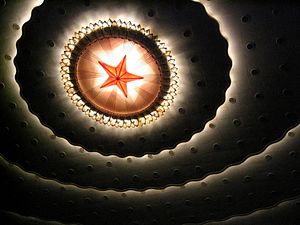The National Committee of the Chinese People’s Political Consultative Conference (CPPCC) will hold its annual meeting starting on March 3, one of the “two sessions” that highlight China’s political calendar each year (the other is the annual meeting of the National People’s Congress, China’s rubber-stamp legislature).
According to the CPPCC’s official website, “The CPPCC is an organization in the patriotic united front of the Chinese people, an important organ for multiparty cooperation and political consultation under the leadership of the Communist Party of China (CPC), and an important means of promoting socialist democracy in China’s political activities.” It has its roots in the days of the Chinese Civil War, when the Chinese Communist Party (CCP) and Nationalist government sought to find a way to resolve their differences through dialogues – resulting in a Political Consultative Conference.
The CPPCC today is a key part of China’s “united front” work, which is designed to liaise with non-Communist Party members – and ultimately see them work with the CCP to advance its interests. The united front – and, as part of it, the CPPCC – thus targets prominent figures in non-political spheres (businesspeople, entertainers, athletes, religious leaders, academics, etc.) and as well non-CCP political figures (such as the heads of China’s other political parties, none of which has any actual sway in governing) and representatives of minority groups as well as diaspora figures. Of course the CPPCC also includes representatives from the Chinese Communist Party itself.
According to the preamble of the Chinese Constitution, the CPPCC is supposed to play an important role in “promoting friendship with other countries and in the struggle for socialist modernization and for the reunification and unity of the country.” Notably, the CPPCC includes representatives from Taiwan, helping further the CCP’s claim that it has sovereignty over the island. (For the full list of the 34 groups that participate in the CPPCC, see here.)
The CPPCC, however, has no official role in the policymaking process. “In practice, CPPCC members serve as advisers for the government and legislative and judicial organs, and put forward proposals on major political and social issues,” according to the body’s self-introduction. Essentially, the CPPCC provides a platform to offer advice and submit policy proposals to the government. But more importantly, membership in the CPPCC offers prestige for the attendees – and also for the CCP, which can point to these figures are prominent supporters. Being a CPPCC National Committee member signals alignment with CCP interests.
Less cynically, submitting proposals via the CPPCC allows members to draw attention to prominent issues in China that may or may not be addressed by the government. Proposals issued at last year’s annual session included legalizing egg freezing for single women, eliminating the “cooling-off” period for divorces, and tightening laws against animal cruelty. These were ultimately not enacted, but their introduction alone sparked debate and attention on social media. To have a more direct impact, however, proposals from the CPPCC must be enacted by the government. Last year, nearly 6,000 proposals were introduced during the CPPCC National Committee meeting; the vast majority of those will never be realized. And keep in mind that CPPCC members are hand-picked by the CCP; they might push the boundaries of policy on issues like women’s rights or environmental policy, but will not break taboos such as suggesting true multi-party governance or an independent judiciary.
A China Daily primer on “five of the most important” CPPCC proposals to become law highlighted the idea to make October 1 China’s National Day in 1949; the move to publish a dictionary aimed at elementary school students in 1979; China’s entry to the UNESCO World Heritage Convention (allowing for Chinese sites to join the World Heritage List) in 1985; the move to a five-day workweek in 1995; and various proposals to lessen air pollution. That gives a good idea of the CPPCC’s impact throughout its 71 year history — that is to say, extremely limited.
The CPPCC has over 2,100 members in its 13th National Committee, with just 441 women, representing only 20 percent of the members. (The full list, in Chinese, is here.) Notable current members include actor Jackie Chen; acclaimed film director Feng Xiaogang; quantum physicist Pan Jianwei; Robin Li, the founder of internet giant Baidu; former NBA star Yao Ming; and former chief executives of Hong Kong C.Y. Leung and Tung Chee-hwa.
The highest-ranking members form the Standing Committee of the CPPCC National Committee, which meets about six times a year (roughly every two months) in between the annual plenary sessions. The CPPCC is chaired by Wang Yang, a member of the CCP’s Politburo Standing Committee and the fourth-ranked leader in China. The CPPCC also has committees at the province, prefecture, and county levels.
As an example of the body’s figurehead role, at the previous meeting of the Standing Committee, held in November 2020, “Members of the Standing Committee of the CPPCC National Committee unanimously agreed that the CPC Central Committee’s proposals for the country’s development plan are inspiring, which set realistic targets and put forward practical and accurate measures.” And Wang added that “the top political task of the CPPCC to thoroughly study, publicize, and implement the guiding principles of the Fifth Plenary Session of the 19th CPC Central Committee.”

































